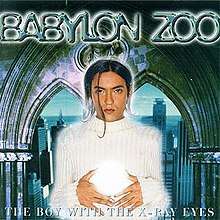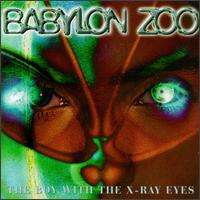The Boy with the X-Ray Eyes
The Boy with the X-Ray Eyes is the debut album by British alternative rock band Babylon Zoo, released in February 1996. It features the single "Spaceman", which charted at number one in the UK Singles Chart after being featured in a popular Levi's jeans TV advertisement in late 1995. Reviews were generally favourable, although the album did not match the commercial success of "Spaceman", peaking at number 6 in the UK Albums Chart. Several negative retrospective pieces have been published, with some describing the album as one of the worst in history.
| The Boy with the X-Ray Eyes | ||||
|---|---|---|---|---|
 | ||||
| Studio album by | ||||
| Released | 5 February 1996 | |||
| Recorded | 1995 | |||
| Genre | Alternative rock, space rock | |||
| Length | 54:47 | |||
| Label | EMI | |||
| Producer | Jas Mann Steve Power | |||
| Babylon Zoo chronology | ||||
| ||||
| Singles from The Boy with the X-Ray Eyes | ||||
| ||||
| Alternative cover | ||||
 US edition cover | ||||
Commercial performance
The Boy with the X-Ray Eyes peaked at number 6 in the UK Albums Chart on 17 February 1996,[1] and lasted a total of six weeks in the top 100 (three in the top 40).[2] Other than the chart-topping "Spaceman", singles released from the album were "Animal Army", which reached number 17 in the UK Singles Chart, and the title track, which peaked at number 32. By the end of 1996, the album had sold around 750,000 copies worldwide, with its main markets in Europe, Japan and Australia.[3] UK sales exceeded 100,000.[4] In two months, the album had sold a "respectable" 12,000 copies in Canada.[5]
Critical reception
| Contemporaneous reviews(published in 1996) | |
|---|---|
| Review scores | |
| Source | Rating |
| The Age | 5/10[6] |
| Alternative Press | |
| Dayton Daily News | |
| The Guardian | |
| Iowa State Daily | |
| The Michigan Daily | |
| Pensacola News Journal | |
| Q | |
| Select | 2/5[14] |
| Times Colonist | |
The Boy with the X-Ray Eyes was generally well-received by critics.[5] In Babylon Zoo's native UK, Observer journalist Neil Spencer noted "a blast of Beatles and a hunk of early [David] Bowie", hailing bandleader Jas Mann as a "hero" and "1996's first real phenomenon".[16] David Sinclair in The Times referred to "a credible and cohesive collection of songs which harnesses a big, distorted guitar sound to a futuristic vision".[17] The Guardian named The Boy with the X-Ray Eyes their "CD of the week". Rick Glanvill said: "This is a fey, pretentious vision of music but deny its energy and style to your detriment... Lyrics aren't a strong point but strong tunes put [Mann] on the harder side of glam."[9] Q's Martin Aston asserted that "Spaceman" is "startlingly great", with the rest of the album being "equally appealing".[13]
There were several negative reviews throughout the British Isles. The Daily Telegraph commended the first two tracks but lost interest thereafter, directing criticism at the "mannered" vocals, "increasingly precious" lyrics, and song arrangements in which "one grinding riff sure enough follows another".[18] Andy Gill in The Independent described the album as "re-heated techno-glam guitar-rock somewhere between Ziggy Stardust and Jesus Jones", which brings home "just how mundane the notionally exotic can be".[19] The Irish Times observed an "outmoded melange of distorted guitars, washed out synthesisers and pseudo sociological sci fi lyrics", listening to which is "not a pleasant experience".[20] The List's Rodger Evans portrayed the record as "wholly uninspired",[21] while Ian Harrison of Select dubbed it "a mime troupe unable to keep quiet".[14]
Stateside, The Boy with the X-Ray Eyes garnered both acclaim and derision. People contended: "[T]he tunes basically reprise the sonic spirit and hooky appeal of ['Spaceman']. Before long you just might find yourself humming them in your sleep."[22] Dave Thompson in Alternative Press felt "no fears for follow-ups" to the lead single, and likened the album to "[David] Bowie's Ziggy Stardust, remixed by the guys from Underworld".[7] New York Times critic Neil Strauss described the record as "wonderful and satisfying in the short term but ultimately disposable".[23] J. D. Considine in The Baltimore Sun chided the album's "shoddy sound and abundant gimmickry", concluding that "it's hard to imagine America falling for this junk".[24] Michigan Daily reporter Heather Phares also predicted a lack of United States success for the group, while taking aim at their "turgid music" and "dogmatic lyrics".[11]
Legacy
| Retrospective reviews(published after 1996) | |
|---|---|
| Review scores | |
| Source | Rating |
| AllMusic | |
| The Virgin Encyclopedia of Nineties Music | |
In The Wee Rock Discography, music historian Martin C. Strong found the album to be "mediocre".[27] Kevin Courtney in The Irish Times described it as "fatally-flawed".[28] Journalist Tim Moore mentioned the record in his book Travels Through Unloved Britain, criticising the length of its tracks as excessive, and calling it "persistently tuneless, repetitive and garbled".[29] AllMusic editor Stephen Thomas Erlewine reflected on an album of songs that lack cohesion and hooks, characterising Mann as "pretentious, not ambitious".[25]
The Boy with the X-Ray Eyes has been named as one of the worst records of all time. In a 1999 article for The Guardian, critic Andrew Mueller called it "one of the most hilariously terrible albums ever made".[30] Q ranked the LP at number 42 in their 2006 list of the 50 worst albums in history.[31] A 2016 public poll organised by online trade-in site Ziffit.com placed it at number 31 in a list of the 50 worst albums ever.[32] The following year, Noisey UK managing editor Daisy Jones ranked 15 "one-hit wonder" records from history, naming The Boy with the X-Ray Eyes as the worst.[33]
Track listing
All tracks written by Jas Mann.
- "Animal Army" – 5:55
- "Spaceman" – 5:41
- "Zodiac Sign" – 4:58
- "Paris Green" – 4:43
- "Confused Art" – 4:32
- "Caffeine" – 6:34
- "The Boy with the X-Ray Eyes" – 4:27
- "Don't Feed the Animals" – 1:38
- "Fire Guided Light" – 6:43
- "Is Your Soul for Sale?" – 5:52
- "I'm Cracking Up I Need a Pill" – 3:46
- A CD promo sampler was also issued that includes the tracks "Spaceman", "Zodiac Sign", "Animal Army" and "I'm Cracking Up I Need a Pill".
Charts
| Chart | Position |
|---|---|
| Australian Albums Chart[34] | 28 |
| UK Albums Chart[2] | 6 |
References
- Roberts, David (2006). British Hit Singles & Albums (19th ed.). London: Guinness World Records Limited. p. 38. ISBN 1-904994-10-5.
- "Babylon Zoo". Official Charts Company. Retrieved 19 December 2018.
- Sinclair, David (22 February 1997). "UK Brits Around the World" (PDF). Billboard. Retrieved 21 December 2016.
- Kwaku; Sexton, Paul (29 March 1997). "Eastern Wave Also Encompasses Pop" (PDF). Billboard. Retrieved 19 December 2018.
- "Babylon Zoo lands in Toronto". Ottawa Citizen: 56 (E12). 23 May 1996.
[T]he CD has been critically well-received around the world.
- "Top 10 of the Britpop Pack". The Age: 46 (Entertainment Guide, p. 14). 24 May 1996.
- Thompson, Dave (June 1996). "Babylon Zoo: The Boy with the X-Ray Eyes". Alternative Press: 69.
- Morosi, Charmaine (5 July 1996). "Recordings on Review". Dayton Daily News: 61 (Go!, p. 15).
- Glanvill, Rick (2 February 1996). "CD of the week: Babylon Zoo". The Guardian: 40 (Friday Review, p. 14).
- Clair, Christopher (15 April 1996). "Check out two discs that get perfect scores this week". Iowa State Daily.
- Phares, Heather (22 April 1996). "Babylon Zoo: The Boy With the X-Ray Eyes". The Michigan Daily. p. 9A. Retrieved 27 May 2013 – via Google News Archive.
- "Briefs". Pensacola News Journal: 11 (3B). 13 May 1996.
- Aston, Martin (March 1996). "Babylon Zoo: The Boy with the X-Ray Eyes". Q: 92.
- Harrison, Ian (February 1996). "New Albums". Select. p. 89. Retrieved 24 July 2013.
- Parisien, Roch (9 May 1996). "Roch on Music". Times Colonist: 25 (C3).
- Spencer, Neil (11 February 1996). "Music Releases". The Observer: 12.
- Sinclair, David (2 February 1996). "Babylon Zoo: The Boy with the X-Ray Eyes". The Times: 31.
- "Animal magic of Spaceman Jas". The Daily Telegraph: 9. 10 February 1996.
- Gill, Andy (2 February 1996). "Record reviews". The Independent. Retrieved 16 December 2018.
- "Rock". The Irish Times. 9 February 1996. Retrieved 2 December 2015.
- Evans, Rodger (23 February 1996). "Babylon Zoo: The Boy with the X-Ray Eyes". The List (273): 46. Retrieved 6 June 2017.
- "The Boy with the X-Ray Eyes". People. 15 April 1996. Retrieved 16 December 2018.
- Strauss, Neil (26 March 1996). "Critic's Choice/Pop CD's; Pushing Beyond Grunge". The New York Times.
- Considine, J. D. (28 March 1996). "Babylon Zoo: The Boy with the X-Ray Eyes". The Baltimore Sun. Archived from the original on 18 June 2012. Retrieved 16 December 2018.
- Erlewine, Stephen Thomas. The Boy with the X-Ray Eyes. AllMusic. Retrieved 19 December 2018.
- Larkin, Colin (2000). The Virgin Encyclopedia of Nineties Music. Virgin Books. p. 30. ISBN 9780753504277.
- Strong, Martin C (1996). The Wee Rock Discography. Canongate. p. 18. ISBN 978-0862416218.
- Courtney, Kevin (12 February 1999). "Rock/Pop". The Irish Times. Retrieved 5 December 2018.
- Moore, Tim (2012). You are Awful (but I Like You): Travels Through Unloved Britain. Vintage. pp. 157–158. ISBN 0-224-09011-9.
- Mueller, Andrew (30 January 1999). "Music". The Guardian: 159 (The Guide, p. 37).
- "The 50 Worst Albums Ever!". Q. May 2006.
- "Top 50 Worst Albums Ever". The Irish News. 8 September 2016. Retrieved 1 January 2019.
- Jones, Daisy (9 May 2017). "A Complete Ranking of 15 One-Hit Wonder Albums from Worst to Best". Noisey UK. Retrieved 10 June 2017.
- "australian-charts.com > Discography Babylon Zoo". Hung Medien. Retrieved 10 November 2015.